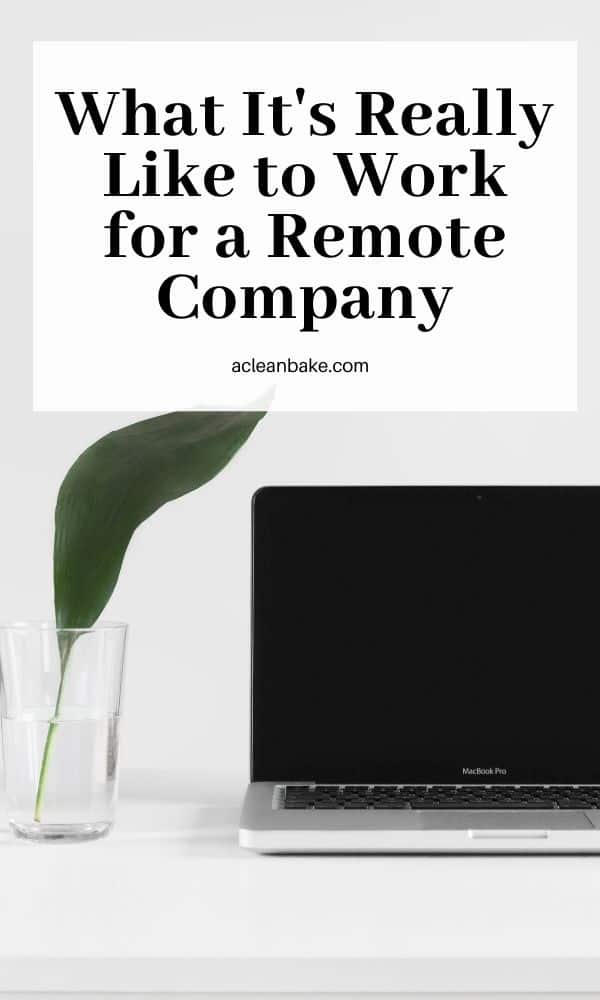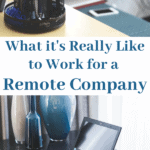Please note: This article was written before the pandemic, which made remote work much more commonplace. However, this information is still accurate and more relevant than ever!
Whether you aspire to be a blogger, a freelancer, or an employee of a remote company, working from home can seem like the sweetest deal ever. No commuting, no rushing out the door every day, no boss looking over your shoulder, and you can work in your PJs.
I work remotely, and can attest to the fact that, while all of these things are true, they’re not the whole truth about what it’s like to work remotely, which is to say at home, alone, all the time.

Every time I post about my remote job on Instagram, I get so many questions. People hear that I work from home, or remotely, and they’re intrigued, impressed, and/or jealous.
Since I have quite a bit of experience working remotely under a variety of conditions, I offered to answer any questions about remote work and in this article, I’ll do my best to answer all of the ones that you sent it, plus the ones I get most frequently.
My Remote Work Credentials
I’m pretty experienced with remote work, having worked partially remotely for about 3 and a half years, and fully for another almost-3.
From 2013-2016, I worked for a company that was locally-based, but which allowed employees the flexibility to work from home when they wanted to. I took full advantage of the policy and only went into the office anywhere from twice a week to 4-5 times per month. Then, I left that company, freelanced for a year, and subsequently took a job working for a fully-remote company, where I’ve been for nearly 3 years.
My current company, Growth Machine, is a content marketing and SEO agency headquartered in Austin, TX. But, we don’t have a single (official) office, our business address is either our founder’s house or a PO box, and our employees work from all corners of the country and sometimes, the world.
I have colleagues in and around Austin, southern California, Atlanta, St. Louis, suburban Ohio, and two team members who travel full time, meaning they don’t have a home base and are always on the road. One of them is living out of a converted van right now (which is much more glamorous than it sounds, believe it or not).
So I’ve had personal experience with a pretty good cross-section of remote work, and I’m here to tell you what it’s really like.

image via unsplash
It’s a real job!
So, to clarify what I said above, remote work and a flexible schedule does not mean that the work isn’t still demanding, prioritized, and deadline-driven.
In fact, when we hire, one of the red flags we look for is when a candidate seems to think that a remote job will be super chill and they can work when they want to, around the edges of their hobby or side hustle. That’s usually an automatic disqualification.
Remote work is just as important and challenging as the work you’d do at an office. Full stop.
Remote Jobs Are More Common Than You May Think.
Lots of people that I talk to are interested in pursuing remote work opportunities, but don’t know where to start. There are a few ways to land a remote job.
First, you can make one for yourself. If you’re working to build a blog or other online business, you’re already on the way. If you have a day job in an office, or are interviewing for one, you can ask your boss whether the company has a remote work policy. If not, why not be the first to write one?
Second, you can look for a remote job at a traditionally-office-based company. More and more companies are open to hiring fully (or mostly) remote worker, even if they have an office. (COVID update: this is more common than ever now!) Remote work is appealing to employers because it allows them to add headcount (in non-corporate speak: “hire more people”) without having to pay for a larger office to house them all. It also allows them to access talent outside of their geographic area. Some industries are a little more likely to hire remote workers, such as marketing or tech firms, consultants, or advertising agencies.
Third, you can look for a remote job with a remote company. There are plenty of online job boards dedicated exclusively to these sorts of jobs, and my favorite is weworkremotely.com. Google will direct you to several more, and if you’re in a creative field, you may have luck finding longer-term remote work on Upwork.com and Fiverr.com. You can also look for job descriptions on major job boards (Indeed.com or Monster.com, for example) that you know are likely to be remote or open to it. For example, most virtual assistants can be anywhere in the world, as can freelance writers. (And, if you’ll indulge me a bit of self-promotion, my company is frequently hiring!)
All of the above, by the way, goes for both part- and full-time remote work.
You Don’t Need To Sacrifice Seniority for Remote Work.
Lots of antiquated beliefs about the workplace and what it takes to succeed and move up the ranks still persist, leading to fallacies like “you have to be seen to be promoted” and “remote work is only for lower-seniority jobs”.
If you’re at a company that still believes those things, and you want to work remotely without sacrificing your career trajectory, it’s time to look for a job at a different company. Fully remote companies like mine are established specifically to be remote, and still need executives and other senior management positions filled.

image via unsplash
The Rumors are True: You Can Work in Your PJs (But You May Not Want To).
The number one question I get (aside from what I do) is whether I work in my pajamas. At first, I did. And, some days, I do my first hour of work in my PJs. So profesh.
But just because you can work in your PJs doesn’t mean you should. Living and working in the same space does enough to break down any boundaries you may have set between your job and your home life, and to be completely frank, it is easy to slide into a downward spiral of laziness if you don’t make an effort to get dressed in the morning.
Even if I’m just switching from PJs to workout gear, I absolutely shower, get dressed, and put on makeup every. single. day. Many days, I have video conferences to attend, so I have to look halfway presentable, but I get ready for the day the rest of the time, too. Doing so is the equivalent of commuting; it says I am here, I am ready for work, and it’s time to focus and get stuff done.
No, You Don’t Watch TV All Day.
This is another stereotype about remote work: that people who work from home really spend most of the day lounging on the couch binge-watching TV.
While I don’t have a dedicated office anymore, and my desk is in the living room where the TV is, I don’t turn it on very often. When I really need a break, I do watch an episode of something while I eat lunch, but I would never get anything done if I had TV on in the background all the time.
When I used to work a much more data-heavy job that required intensive quantitative analysis and coding search strings for hours at a time, I did sometimes work with the TV on because it somehow kept me more alert if I wasn’t focused on the numbers alone.
Now, I find the opposite: with the work that I now do, which involves a lot of collaboration, focus, problem-solving, and critical thinking, having another screen is distracting and I end up feeling completely drained by early afternoon. So, no, I don’t watch TV during the day, and the truth is that I don’t even want to.

image via unsplash
You Get Much More Control Over Your Time.
When you work a traditional office job, you’re expected to be at your desk during normal business hours, except for lunchtime, and leaving in the middle of the afternoon to go to a doctor’s appointment is, typically, a rarity.
Working remotely from home allows you to go to a doctor’s appointment, or to the gym, when you want to. We have a rule that everyone needs to be online from 11-4pm central time every weekday (unless the office is closed), but people frequently need to step out during that time period and they just let the team know.
I’ve been able to go to the doctor, go for a run, hit the post office, and run a sandwich to my son’s school in the middle of the day with no issues. Actually, I was in a meeting for that last one! #remoteworklife
Of course, the caveat is that, if I duck out for an hour in the middle of the day, that doesn’t excuse me from finishing my work for the day, but I appreciate the flexibility to choose when I work vs when I take care of personal needs.
This also holds for blogging. When I first started, I negotiated a 4-day workweek, so I had Fridays off to take care of blogging. Now, since the company and my job has grown, I can’t usually take Friday completely off. So I do my blog work in fits and spurts, and I’ve also cut out a lot of nonessential blog work, scaled down the whole operation, and outsourced anything that is important, but does not require my voice or touch (like recipe development, which I will obviously NEVER outsource; read more about all of this here).
It’s Not for Everyone.
This is a really, really important one, and another issue I’ve seen time and again when hiring. Some people think they want a remote job, but aren’t prepared for the isolation (more on that in a second), intense time management, and high degree of self-motivation that is required.
Make sure you are prepared for the reality of it before you apply for a fully remote job. If you’re a blogger or freelancer on the side of a full time office job, you probably already have a decent sense of what remote work feels like, so just make sure it is the right fit.
It may not be for you.

It Can Be Lonely.
I am almost as frequently asked if I get lonely, or start to go stir crazy. The answer is a resounding YES.
To be clear, I am a card-carrying introvert, and I love being alone. But this is on a whole other level. I’ve been alone for most of the day, 5 days a week, for the better part of 6 years. That’s a lot of alone time, and it used to bother me less because when I needed human interaction, I could go into the office.
Now that I’ve switched jobs, there is no office to go to. Being cooped up for too long in a small city apartment, alone, can drive even the most committed introvert over the edge. It takes a great deal of energy to resist inertia and get myself out of the house, so I try to be very tuned in to how I am feeling (focused or distracted? energized or lethargic?) and how productive I am being, and force myself to find a change of scenery when my energy or focus starts to drop.
I try to coordinate with friends in the neighborhood who also work remotely, but it works out a lot less often than I’d like. So most of the time, I just go to Starbucks by myself. I could join a co-working space, but I know myself, and I probably wouldn’t make an effort to get to know anyone there, since they’re all doing different work (basically, like Starbucks, but with a membership fee).
When I first started working 100% remotely, I never expected to miss having coworkers as much as it turns out I do.
Face-to-Face Communication is Still Critically Important.
Yes, communication looks very different among colleagues in a remote company. With everyone on a different schedule and in a different time zone, you not only can’t just get up and go to their desk to ask them a question, you can’t always message them and get an immediate response.
My company facilitates communication in a couple of different ways:
- We use Slack for instant messaging, which not only allows for group chats and direct messages, but also has a phone app, so you can respond to any message, anytime, from anywhere in the world that has wifi.
- We use Asana for Project Management, which allows you to leave comments and tag colleagues (which alerts them in the software, and also sends them an email notification), they can respond to less urgent, topic specific questions when they have a chance (and you don’t have to remember to ask them next time you’re chatting with them directly).
- We use Google Drive for all documents, spreadsheets, presentations, and file storage, so that everyone can access whatever they need without having to send files around or messing with a VPN (Virtual Private Network), which is notoriously, infamously disruptive to productivity.
Despite all of these digital communication methods at our disposal, we don’t let face-to-face communication become an afterthought. Without face-to-face conversations, it is easy to forget that you’re working with other people, not just words on the computer. And for collaboration, brainstorming, and problem-solving, absolutely nothing comes close to working as well as an in-person (err, so to speak) discussion.
We use Zoom video conferencing for face-to-face meetings. It’s basically like Facetime, but for business. This is not the same as working in the same room as someone, but sometimes you can get so much more accomplished by chatting for 30 minutes than you can messaging on Slack for the entire day.
We have team and departmental video conferences with the entire company (12 full time employees; we also have ~30 contract employees but they don’t attend the team meeting) each week, monthly or bi-weekly video conferences between managers and each of their direct reports, and my boss and I (I’m the COO, he’s the CEO) meet weekly to touch base, address issues, and plan for growth and expansion.

image via unsplash
You Can Still Bond With Your Coworkers. It Just Happens Differently.
Like I said, we still communicate face-t0-face, and some of us are quicker to hop on a video conference than others (i.e. some of my coworkers prefer to message on Slack whereas others prefer to talk through complex issues on a video call).
But, perhaps, one of the most important things we do is to meet up a couple times a year in the same city to work, eat, and hang out together for a week. This intensive bonding is certainly different than the way bonding happens with coworkers in a standard office job, and it took me a little bit of time to adjust to the idea of these retreats, but I quickly found that I really enjoyed them.
They are also absolutely critical for introducing newer employees (that is, employees hired since the last retreat) to the team and getting to know them. When we were smaller – we only had 4-5 employees, including me, for a long time – it was much easier to bond from afar, but now that the group has tripled, and is still growing, the retreats are more important than ever.
Here’s how we do it: we fly everyone to a centrally-located city and put them up in a hotel together. We meet up at 9am, work until lunchtime, have lunch together, work a few more hours together, then there is some free time for people to rest, call home, explore the city, or whatever they want to do. We meet up again in the evening for dinner, and then those who want to go out for after-dinner drinks. Our team is especially fond of arcade bars ?. So far, we’ve done this in Austin twice, LA once, and Chicago just last week, as you may have seen on my Instagram stories. We try to stick to cities where at least one team member lives, but that may change.
As we grow, we’re going to start having to gradually adjust how we do these, since it’s getting harder to find workspaces and restaurants that can accommodate our entire group, and they’re getting incredibly expensive to do right. But we will never stop doing them, since they facilitate an absolutely invaluable type of bonding that helps us learn all the nuances of each other’s work styles, communication preferences, and personality quirks that we need to know to get great work done on a daily basis.
Overall, I Love It
Obviously, there are pros and cons to working remotely, but it works really well for me and I will continue to work remotely for as long as I can.
If you have any more questions, I would love to answer them. Please leave me a comment below!




ROZANNE CUPURO says
Being another full time “remotee” for coming up on 3 years, this is a very accurate representation of my work life. When the workload was extremely high and required a lot of extra time, it was very easy and convenient to work longer. Now that the amount of projects and work are back to manageable levels, I am very protective of my home/work boundaries.
Nora (A Clean Bake) says
So glad you can relate!